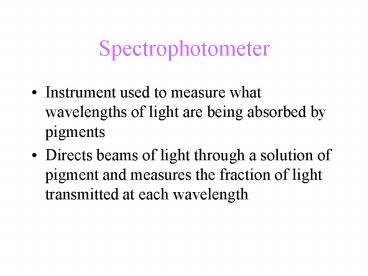Spectrophotometer - PowerPoint PPT Presentation
1 / 21
Title:
Spectrophotometer
Description:
Spectrophotometer. Instrument used to measure what wavelengths of light are being ... When a molecule absorbs a photon, one of the molecule's electrons is elevated to ... – PowerPoint PPT presentation
Number of Views:225
Avg rating:3.0/5.0
Title: Spectrophotometer
1
Spectrophotometer
- Instrument used to measure what wavelengths of
light are being absorbed by pigments - Directs beams of light through a solution of
pigment and measures the fraction of light
transmitted at each wavelength
2
Figure 10.7 Determining an absorption spectrum
3
What happens when pigments absorb photons.
- When a molecule absorbs a photon, one of the
molecules electrons is elevated to an orbital
where it has more potential energy - Normal level ground state
- Higher energy level excited state
- see pages 184-185
4
Figure 10.12 How noncyclic electron flow during
the light reactions generates ATP and NADPH
(Layer 1)
5
Figure 10.12 How noncyclic electron flow during
the light reactions generates ATP and NADPH
(Layer 2)
6
Figure 10.12 How noncyclic electron flow during
the light reactions generates ATP and NADPH
(Layer 3)
7
Figure 10.12 How noncyclic electron flow during
the light reactions generates ATP and NADPH
(Layer 4)
8
Figure 10.12 How noncyclic electron flow during
the light reactions generates ATP and NADPH
(Layer 5)
9
Photophosphorylation
- Method of generating ATP by using light to add P
to ADP - Occurs in Light Reactions
10
Cyclic vs. Noncyclic electron flow
- Noncyclic pg 186
- uses Photosystem II, an ETC (with the electron
carrier plastoquinone, Pq) , Photosystem I, and
another ETC using an iron-containing protein
called ferredoxin - Cyclic pg. 187
- uses only Photosystem I and the second ETC no
production of NADPH and no release of Oxygen, but
DOES produce ATP to be used to make up the
difference needed due to Calvin cycle demands..
11
Figure 10.14 Cyclic electron flow
12
Chemiosmosis is similar in Chloroplasts and
Mitochondria
- In both, ETC pumps protons across a membrane from
areas of low concentration to high concentration
- When these protons diffuse back across the
membrane through ATP synthase, they drive the
synthesis of ATP - See page 188
13
Figure 10.16 The light reactions and
chemiosmosis the organization of the thylakoid
membrane
14
Figure 10.15 Comparison of chemiosmosis in
mitochondria and chloroplasts
15
Calvin Cycle
- Three phases
- 1. Carbon fixation CO2 it attached to RuBP
catalyzed by the enzyme rubisco (most plants
are called C3 plants because first intermediate
is 3-phosphoglycerate) - 2. Reduction
- 3. Regeneration of RuBP
16
Figure 10.17 The Calvin cycle (Layer 3)
17
Alternatives mechanisms of carbon fixation
- Photorespiration occurs when O2 levels overtake
CO2 levels rubisco adds O2 to the Calvin cycle
instead of CO2, the product splits, and the 2-C
carbon gets exported from the chloroplast
mitochondria and peroxisomes break this down into
CO2 - MAKES NO ATP AND GENERATES NO FOOD!!!
- photorespiration decreases photosynthetic output
by diverting organic material from the Calvin
cycle
18
- C4 pathways preface the Calvin cycle with an
alternate mode of carbon fixation and four carbon
compound is first product (sugarcane and corn) - Uses different CELLS to do carbon fixation and
the Calvin cycle spatial separation see page
193 - CO2 PEP make oxaloacetate
19
- CAM plants adaptation to arid conditions found
in succulents - Carbon fixation occurs in same cells, but at
different times temporal separationof processes - Open stomata during night and close them during
day - Make organic acids at night and store them in
vacuoles until morning when stomata close and
light reactions can supply ATP and Calvin cycle
(then, release CO2 from acids) - Crassulacean acid metabolism
20
Figure 10.19 C4 and CAM photosynthesis compared
21
Figure 10.20 A review of photosynthesis































